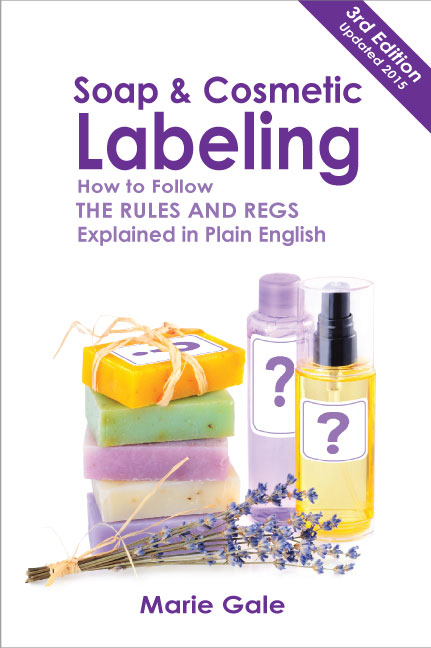Ingredients are supposed to be listed in the ingredient declaration in “descending order of predominance.” In other words, the ingredient at the highest percentage (by weight) goes first, then then next highest, etc. Ingredients that are present at less than 1% can be listed in any order following the ingredients present at 1% or greater.
When a blended ingredient is used, all the component ingredients in it must be listed separately in the ingredient declaration, correctly placed in the descending order of predominance based on the component ingredient’s percentage of the entire formula.
So, how do you figure that out? Actually, it’s simple math, and not too hard when you know the formulas. Here’s an example:

Starting Formulation
Let’s say you are making soap. You purchased a blended oil as your base and added some shea butter. Your recipe might look like this:
| blended oil | 50 oz |
| shea butter | 10 oz |
| lye | 8.67 oz |
| water | 17.6 oz |
| fragrance | 2 oz |
Blended Oil
Next, you need to calculate the of amount of each oil in the blended oil that is actually in your soap. In order to do this, you’ll need to get the percentages of the component ingredients from your supplier.
Let’s say the formula for the blended oils is:
| coconut oil | 24% |
| olive oil | 26% |
| palm oil | 45% |
| castor oil | 5% |
The formulation has 50 oz of the blended oil, so to calculate the amount of each individual oil, multiply the total amount of blended oil by the percentage of the individual oil:
| coconut oil | 24% x 50 oz (blended) | = 12 oz |
| olive oil | 26% x 50 oz (blended) | = 13 oz |
| palm oil | 45% x 50 oz (blended) | = 22.5 oz |
| castor oil | 5% x 50 oz (blended) | = 2.5 oz |
Detailed formulation
So now your formulation actually looks like this:
| coconut oil | 12 oz |
| olive oil | 13 oz |
| palm oil | 22.5 oz |
| castor oil | 2.5 oz |
| shea butter | 10 oz |
| lye | 8.67 oz |
| water | 17.6 oz |
| fragrance | 2 oz |
| TOTAL | 88.27 oz |
Put it in order
Then put the ingredients in descending order by the amount, and there you have your order for your ingredient declaration.
| palm oil | 22.5 oz |
| water | 17.6 oz |
| olive oil | 13 oz |
| coconut oil | 12 oz |
| shea butter | 10 oz |
| lye | 8.67 oz |
| castor oil | 2.5 oz |
| fragrance | 2 oz |
Ingredients: palm oil, water, olive oil, coconut oil, shea butter, sodium hydroxide, castor oil, fragrance.
Calculate percentages
Sometimes it’s good to know the percentage of each ingredient. It’s helpful when resizing a recipe, and can also help with the ingredient declaration.
To calculate the percentage of each ingredient, divide the amount of that ingredient by the total amount:
| coconut oil | 12 oz / 88.27 | = 13.59% |
| olive oil | 13 oz / 88.27 | = 14.73% |
| palm oil | 22.5 oz / 88.27 | = 25.49% |
| castor oil | 2.5 oz / 88.27 | = 2.83% |
| shea butter | 10 oz / 88.27 | = 11.33% |
| lye | 8.67 oz / 88.27 | = 9.82% |
| water | 17.6 oz / 88.27 | = 19.94% |
| fragrance | 2 oz / 88.27 | = 2.27% |
In this example, there aren’t any ingredients present at less than 1%. Sometimes, especially when dealing with blended ingredients in small quantities (like preservatives, for example), the resultant component ingredients are present at less than 1% of the total formulation. In those cases, the ingredients at less than 1% can be listed in any order, making the process easier.



Leave a Reply